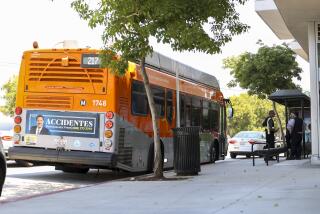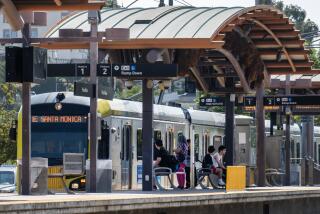More Commuters Finding Metrolink Serves Their Needs : Transportation: Officials report increase in train travel’s appeal, and users sound positive. But concerns still center on funding.
As the shrill whistle announced the Wednesday afternoon arrival of the Metrolink train in Simi Valley, commuters returning home from Los Angeles lined up eagerly inside the train doors, poised to dash from the platform to their waiting cars.
*
For some commuters, it is a routine that began two years ago, when the plush periwinkle-and-white trains first rolled into Ventura County.
For others, more reluctant to surrender the comfort of the single occupancy vehicle, it is a service discovered gradually, then embraced enthusiastically.
“At first I didn’t know if I’d like it, but now I really enjoy it,” said Linda Bruno, who began taking the train in September to her job as a customer service representative in Downtown Los Angeles. “It’s easy and convenient and much less stressful than driving.”
Over the past year, Metrolink has whisked a growing number of commuters through earthquakes, fires and traffic jams, over 346 miles of track in five counties.
In Ventura County alone, ridership has grown from 600 passengers a day in Moorpark and Simi Valley to nearly 1,400 daily riders catching the train in those cities as well as Camarillo and Oxnard. After the Jan. 17 earthquake, the Camarillo and Oxnard stops were added to help handle the passenger load and encourage commuters to get off congested roads and onto the train.
Since the earthquake, more commuters on the Ventura County Line have switched from driving to train riding than on any other route in the system, said Peter Hidalgo, a Metrolink spokesman.
“Ventura County commuters have been very receptive to Metrolink,” Hidalgo said. “It’s a very good trend that shows that people do see the train as a viable way to get to work.”
But Metrolink has not been without problems.
Commuters complain that the trains don’t come often enough and are too often late, according to a Metrolink commuter survey. Trains to Ventura County are late more often than on any other line in the system. Trains on the Ventura County route also stop in Chatsworth, Northridge, Burbank, Van Nuys and Glendale before reaching Los Angeles Union Station.
Loraine Qubesh regularly catches the train from Moorpark to Downtown Los Angeles, where she has served on a federal grand jury for the past year.
Qubesh said she would like to see more trains in the afternoon, but is generally pleased with the service.
“When I started on this jury it didn’t even occur to me to take the train until a court reporter gave me a schedule,” Qubesh said. “Now I wouldn’t dream of driving.”
*
For Simi Valley commuter Renee Romanowski, the cost of Metrolink is an important consideration. She began taking the train to work after her employer, First Interstate, offered a deep discount on 10-day passes.
The passes, which usually run $45, cost Romanowski just $15.
“It’s a great deal,” Romanowski said. “I think the high fares keep a lot of people away.”
Though Metrolink has no plans to permanently lower its fares, transportation officials said they hope improvements in service will attract more riders in the coming year. On-time arrivals have increased substantially in recent months, and Metrolink officials are studying the possibility of making more weekday runs and adding weekend trains.
“The first two years we focused on getting this thing going,” said Bill Davis, a Simi Valley councilman and member of the Ventura County Transportation Commission. “Now we’re really going to focus on working out all the kinks and getting this thing running perfectly.”
*
For some city and county leaders, kinks in service are just part of the problem. They worry about future funding for the trains as competition for state and federal transportation dollars intensifies.
Metrolink is heavily subsidized, with government agencies kicking in an average of nearly $7 per rider. Service to Ventura County costs about $1.6 million a year.
Unless ridership increases dramatically, some city and county leaders fear that the price of running Metrolink may be too high for trains that carry just a fraction of Ventura County’s commuters to work.
“I think that over the next six months we really need to increase the number of riders, especially in Oxnard,” said John K. Flynn, a county supervisor who also serves as an alternate on the Transportation Commission.
“Metrolink is a wonderful service,” Flynn said. “If we can double the number of people boarding in Oxnard, I’ll feel comfortable backing it with vigor at budget time.”
Metrolink Report Card An update on ridership and on-time performance for Metrolink service in Ventura County, on its two-year anniversary.
Ridership Average daily ridership peaked after the Jan. 17 earthquake and has since fallen off. For the Ventura County Line from Oxnard to Los Angeles Union Station: September, 1994: 2,690 In February, 1994, service to Camarillo was added. In April, 1994, service to Oxnard was added.
On-time Performance On the Ventura County Line between Ventura County and Los Angeles: 1994: 85% Source: Metrolink
Metrolink at a Glance
Ventura County Systemwide* Average daily ridership 2,690 15,221 On-time performance 85% 91% Stations in service 10 38 Trains per day 16 75 Miles covered 66 346
* Includes service to Los Angeles, Orange, Riverside, San Bernardino and Ventura counties.
Source: Metrolink
More to Read
Sign up for Essential California
The most important California stories and recommendations in your inbox every morning.
You may occasionally receive promotional content from the Los Angeles Times.









